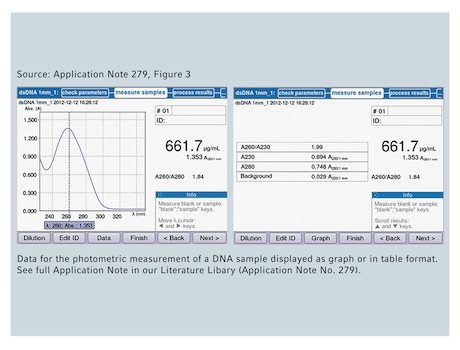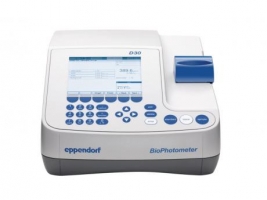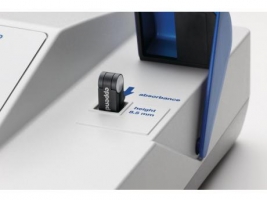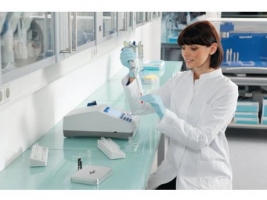BioPhotometer® D30
Product Information
The Eppendorf BioPhotometer D30 is the 3rd generation of Eppendorf BioPhotometers which have become an established standard in the field of life sciences. It utilizes fixed wavelengths, making the Eppendorf BioPhotometer D30 the ideal device for quick and precise routine applications. The ultra-stable Xenon light source quickly lights up for immediate instrument use. Data is clearly processed making the evaluation of results fast and simple while minimizing mistakes. Additional help menus assist the user and offer an additional level of security. Relevant ratios are automatically determined for the corresponding applications. The Eppendorf BioPhotometer D30 offers the option of recording a scan for specific applications in the UV range. This allows a quick visual identification of contaminants in the sample.
Nucleic acid purification is a major application in molecular laboratories. Purity and homogeneity of the sample are important considerations for subsequent applications. In practice, nucleic acids are purified with the help of commercially available kits which allow for the separation of most cellular components. However, the presence of proteins or other organic components in the eluate may not be entirely eliminated. When purifying nucleic acid without a kit, additional contamination risks are posed by the chemicals used in the process, e.g. phenol or ethanol from a phenol/chloroform extraction. To ensure minimum contamination of the sample, it is essential to verify its purity by photometric measurements. The ratios of the absorbance values at the wavelengths 230 nm, 260 nm and 280 nm (260 nm/230 nm and 260 nm/280 nm), provide a clear picture of the purity of a nucleic acid sample. The following values represent a pure DNA sample:

In general, the purity of a DNA solution is easily defined using purity ratios. It is possible that reduced purity may be attributed to the fact that the sample is solubilized in water instead of in buffer. Since water and buffer have different properties, the absorbance of the sample being measured will be affected by this disparity. For this reason, the BioPhotometer D30 is capable of recording a “Purity Scan” which displays the absorbance properties of a sample graphically, thus enabling fast and simple visual quality control. In addition, all important raw data pertaining to the DNA sample are displayed in table format. The table optionally lists the purity ratios (A260/A230 and A260/A280), the absorbance values (raw data), as well as the background absorbance, e.g. at 320 nm. Thus, the two display formats complement each other perfectly to allow for an evaluation of the quality of a DNA sample.
Features
- Absorption measurements for one or more fixed wavelengths
- Scan for specific UV applications with automatically determined purity ratios
- Preprogrammed applications for quick start and applications with evaluation via factor, standard or standard series
- Integrated application and results memory
- Data transfer via USB interface, Ethernet or via e-mail and direct printout of results
- Xenon flash lamp with very long lifetime
- Guided software process to minimize errors
- Help box with explanation of each individual step in 5 languages
- Compatible with microvolume measuring cells and standard cuvettes
- Integrated self-test and calibration history
Applications
- Nucleic acid quantification
- Direct protein quantification (UV 280 nm)
- Microvolume measurement via µCuvette G1.0 for highly concentrated samples
- Bacteria growth measurement (OD 600)
- Colorimetric assays for protein quantification, e.g., BCA, Bradford, Lowry
- 340 nm: assays using NADPH or NAPH
- 405 nm: assays using para-nitrophenol
- 490 nm: cytotoxicity assay




